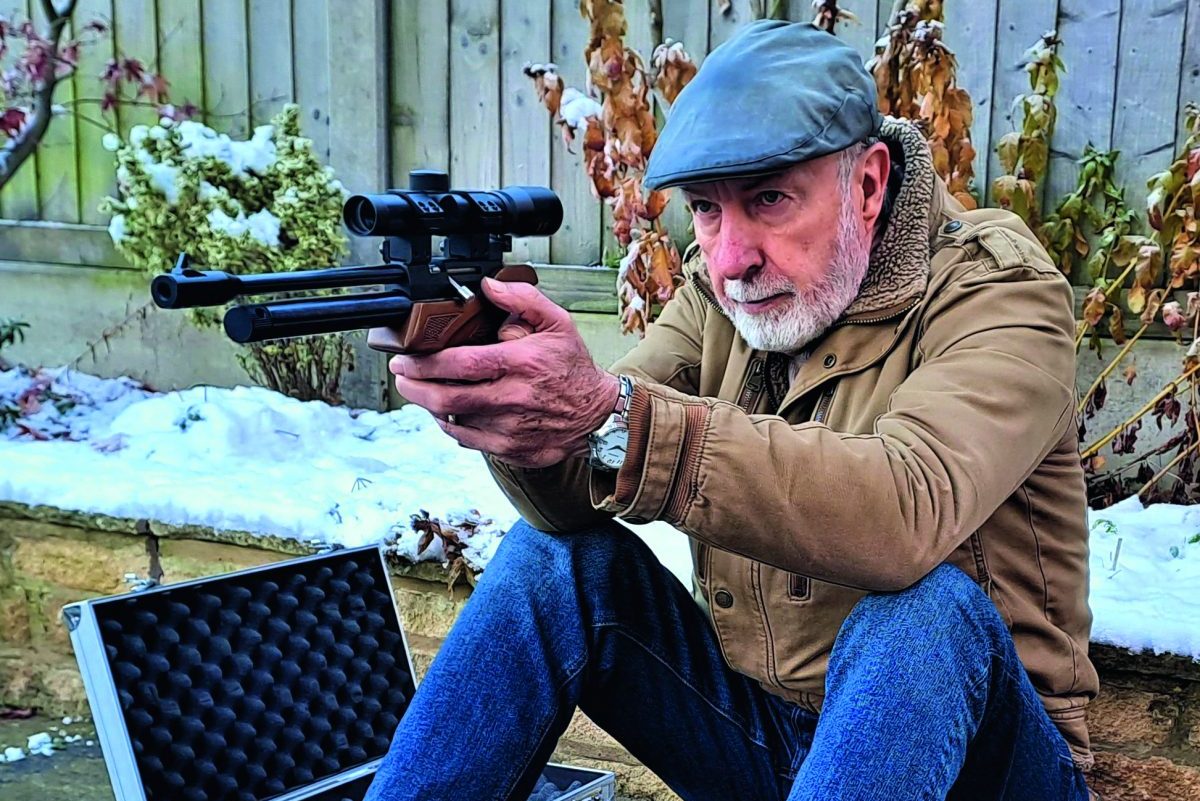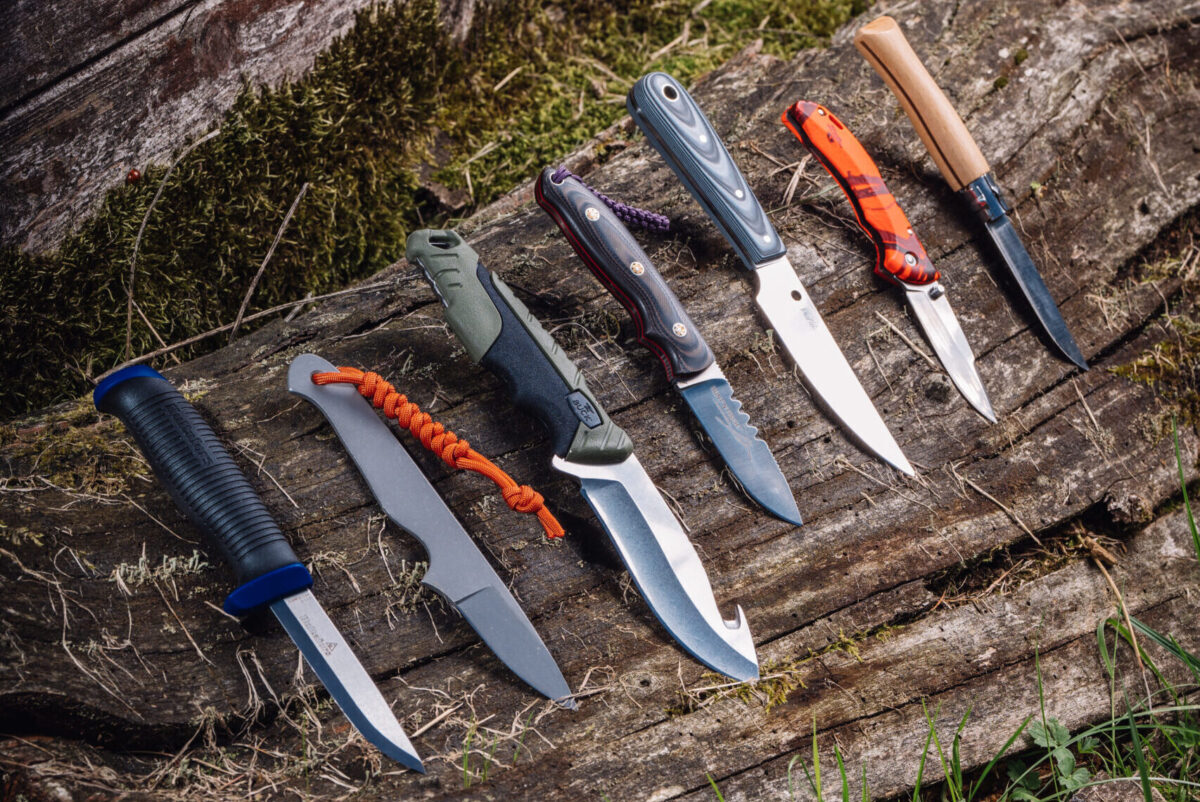How to get the most out of a pistol scope
Phil Hooper examines the history of the pistol scope, and offers some advice to get the best results from a handgun optic

Phil finds that shooting from a sitting position works well with a scoped pistol as he’s able to adopt a more stable aim
My first air pistol was a Webley Senior. I loved that pistol, but fitting a scope to it would never have crossed my mind. This was probably just as well, as the design would have made this virtually impossible! A laser sight slung under the cylinder perhaps, but lasers were only found in laboratories in those days. My shooting buddy had an Original Model 5 air pistol, for which we made a skeleton butt stock. If it had had provision for doing so, fitting a pistol scope could have made sense.
In 1964, a radical new pistol was launched in the USA – the Remington XP-100. In effect, it was a cut-down rifle in a nylon stock. I read a review of this pistol at the time – it was chambered for the .221 Remington Fireball cartridge and fitted with a 2-4×20 Redfield scope. With hand-loaded cartridges, a certain Les Bowmen then shot a 0.72in group at 100 yards. For me, that was convincing evidence that scopes and pistols could belong together!
Weighing up the wobble
The first UK-produced air pistols with provision for a scope were the second generation BSA Scorpion of 1975 and Webley’s Hurricane and Typhoon of 1977. I owned an earlier Scorpion in .177, and it was both powerful and accurate out to 30 yards, with an excellent trigger. Had I had a scope, then that would have been a very useful addition.
Despite the potential benefits of adding a scope to an accurate pistol, there can also be downsides. The weight and handling may be affected to a greater degree than it would be for a rifle, as the scope weight can amount to a bigger percentage of the weight of the combination. It could be that a red dot sight is better in this respect, but with the penalty of less precision than crosshairs provide. Or for shorter ranges, using a laser sight might be an option.
Even a 2x scope will magnify your wobbles, and it is generally harder to hold a pistol steady than a rifle. A single-hand hold may need to be replaced by a two-hand or ‘combat’ hold.
Shooting from a sitting position, with an elbow rested on each knee, works for me. Even better, shooting from a rest, be that a Trigger Stick or bench, would provide enhanced stability. However, if the pistol is a spring-piston design, then it would be better to have a supporting hand on the rest bag with no part of the pistol touching it, or the gun will be unable to recoil freely or uniformly and accuracy will suffer.

The BSA Scorpion was an accurate break-barrel pistol that was well-deserving of the scope rail that was fitted to later versions
Mounting a scope satisfactorily can be easier on CO2 or PCP pistols. If installing a scope on a spring-piston pistol, then a recoil arrestor will usually be necessary. The position of the arrestor will depend on the direction in which the piston travels. So in my earlier example of the Scorpion, the recoil is similar to most spring-piston air rifles, and the arrestor would be clamped to the dovetail rail behind the front, rear or one-piece mount. However, for the Weihrauch HW45, where the piston travels backwards on firing, the recoil is forwards and therefor the arrestor block is fitted in front of the mount.
Ahead of this consideration is the necessity to source mounts that are correct for the pistol in question. In my HW45 example, the dovetail width is non-standard and compatible mounts are needed. If the pistol has recoil stud locator holes, then using mounts with a stud will eliminate scope movement under recoil. Similarly, a pistol fitted with a Picatinny or Weaver rail, matched with the correct mounts, will not need an arrestor.

The mighty Weihrauch HW45 has a rail to take a scope, but will need an arrestor block as well to prevent any scope creep
With CO2, PCP, single-stroke pneumatic or multi-pump pneumatic pistols, recoil will not be an issue. For this reason, the benefits of fitting a scope may be more accessible, and can then enable the full accuracy potential of the gun to be realised. If mounting a scope to a single- or multi-pump pneumatic, then the manner in which the pistol is held for charging needs to be taken into account. If possible, it is better that the pumping effort is not reacted through the scope.
Whether or not this can be achieved, if two-piece mounts are used then they should be spaced as far apart as the pistol, scope and rail configuration allow, in order to ensure maximum rigidity.
Mount up
On a single-shot pistol, ensure that neither the scope nor mounts will impede loading. For a multi-shot pistol, clearance for the magazine may necessitate the use of higher mounts, otherwise mounts should be as low as possible. The Crosman 1377 can benefit from scope fitment, but will need either the dovetail-grooved steel bolt housing, or the purpose-designed clamp-on blocks, both of which Crosman markets.

The Crosman 1377 is another pistol that deserves a scope, but requires additional factory parts before one can be fitted
The Webley Alecto is another pump-up pistol worthy of a scope, and it has a rail. Amongst PCP pistols, the HW44 must surely be an excellent candidate for a top quality scope, as are, for example, pistols from the Brocock stable.
Mounting a scope to a pistol then follows the same procedure as for a rifle. Having determined the position, attach the mount(s) with top halves removed, place the scope body in place, attach the mount top halves and tighten only lightly. Then rotate the scope until the crosshairs are exactly aligned horizontally and vertically in relationship to the pistol frame. Take time over this and make sure you get it spot-on.
Next, tighten the Allen screws, including the mount-to-dovetail screws. Some people recommend turning the Allen key with the short arm to avoid over-tightening; my advice is to go a little tighter than this, but take care to avoid stripping any threads.

Phil’s advice is to fit only quality mounts and use a recoil stud or arrestor block on spring guns
Eye relief for a pistol scope is much longer and more accommodating than for a rifle scope. This is why I have given the positioning guidance above, seeking maximum strength, whereas on a rifle gaining the correct eye relief can make positioning less flexible.
Focusing is the next stage, and for most pistol scopes the procedure is as follows: the threaded locking collar inboard of the eyepiece is loosened. The eyepiece is then rotated multiple turns to go from a fuzzy image to a sharp image and beyond to a fuzzy image, then back to the sharpest image possible. Look away and then back again; your eye muscles should not have to pull the image into focus. Retighten the locking collar.
Do not rush this process, as the reticle needs to be pin-sharp for your eyes, not anyone else’s.
Sighting-in
Sighting-in is a similar process to that for a rifle. My approach with a pistol is as follows: find a largish, plain cardboard box and mark a 1in round black mark in the middle of one surface, or use a Birchwood Casey target spot. Place the box 10 yards away from your firing point with a safe backstop behind. Adopt the shooting position you are most likely to use with the pistol – the more stable the hold, and the better consistency, then the fewer shots will be necessary and the quicker the process. Fire one shot, and note its position relative to the centre of your target. Most scopes have ¼ minute of angle (MOA) clicks, with each click representing 0.25in displacement at 100 yards.
So if the pellet hole is 1in high and ½in to the left of the aiming mark, then the elevation turret should be turned 40 clicks (each click = 0.025in at 10 yards) in the ‘down’ direction, and 20 clicks in the ‘right’ direction. Now fire your second shot, and if you got your sums and direction of rotation correct, it should be ‘in the black’. Now move the target to the range at which you want to set your zero – let’s say 25 yards.
Fire three carefully aimed shots and take the mid-point of the group. Again, measure the position relative to the centre of the aiming mark. At this range, for ¼ MOA graduations, each click will move the shot by 0.0625in (0.25in÷4) so that, if the group centre is ½in low and ¼in to the right, the elevation and windage turret adjustments will need to be eight clicks and four clicks respectively. Make these adjustments, and your next couple of shots should both be centred within the aiming mark. That’s it – all sighted-in with just seven shots!
Fun’s in sight
Fine-tuning with a proper target can follow. The reason for initially using a box was to spot any shots that were wide of the mark. If the scope was seriously misaligned for some reason, or a turret set far away from mid-travel (which could be checked beforehand), then shots could go wild.
Most pistol scopes have plenty of adjustment available, but with a low-powered pistol, particularly in .22 or .25 calibre, you could run out of vertical adjustment at extended ranges due to pellet drop, and need specialist scope mounts to gain sufficient elevation.
There are plenty of pistol scopes out there with fixed or zoom magnification, differing objective lens sizes, reticle type, dimensions, weight and quality. Remarkably, scopes are available from just £30, and some include mounts. For a 2×20 scope with a 25mm tube, value-for-money brands include AGS, SMK, Weihrauch and PAO, which also does a 2-8×32 scope.
With the right pistol and scope combination, you may realise an accuracy potential well beyond that possible with open sights and have a whole lot more fun along the way!

Here is Phil’s SMK CP1 that’s been paired with a scope from the same manufacturer – a budget combination, but very accurate







